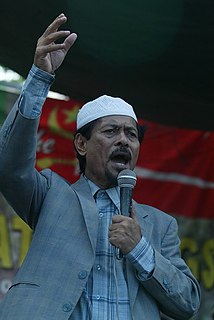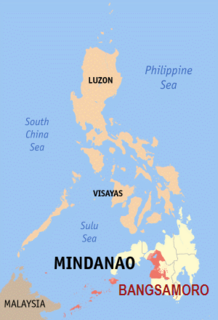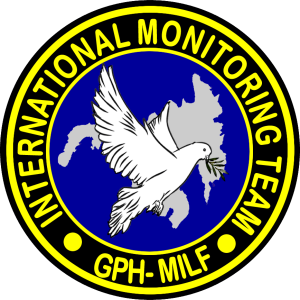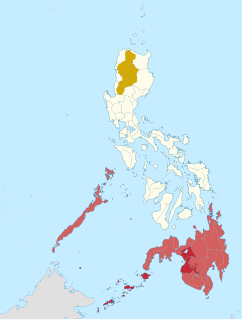
The Moro Islamic Liberation Front is a group based in Mindanao, Philippines, seeking an autonomous region of the Moro people from the central government. The group has a presence in the Bangsamoro region of Mindanao, the Sulu Archipelago, Palawan, Basilan, and other neighbouring islands. The armed wing of the group was the Bangsamoro Islamic Armed Forces (BIAF), although the name of its parent organization, the MILF, was often used to refer to the BIAF. In July, 2018, the Philippines government passed the Bangsamoro Organic Law, giving more autonomy to Muslims. In return, MILF announced that it would disarm its 30,000 fighters.

The Autonomous Region in Muslim Mindanao was an autonomous region of the Philippines, located in the Mindanao island group of the Philippines, that consisted of five predominantly Muslim provinces: Basilan, Lanao del Sur, Maguindanao, Sulu, and Tawi-Tawi. It was the only region that had its own government. The region's de facto seat of government was Cotabato City, although this self-governing city was outside its jurisdiction.

The Moro people or Bangsamoro people are the 13 Muslim-majority ethnolinguistic Austronesian groups of Mindanao, Sulu, and Palawan, native to the region known as the Bangsamoro. As Muslim-majority ethnic groups, they form the largest non-Christian population in the Philippines, and comprise about 5% of the country's total population, or 5 million people.

The Moro National Liberation Front is a political organization in the Philippines that was founded in 1972. It started as a splinter group of the Muslim Independence Movement. The MNLF was the leading organization among Moro separatists for about two decades beginning from the 1970s.

Nur Misuari is a Moro Filipino revolutionary and politician, founder and leader of the Moro National Liberation Front.

The Moro conflict is an insurgency in the Mindanao region of the Philippines, which has involved multiple armed groups, and has been ongoing since March 1968. Peace deals have been signed between the Philippine government and two major armed groups - the Moro National Liberation Front (MNLF) and the Moro Islamic Liberation Front (MILF) - but other, smaller armed groups continue to exist.

The Moro National Liberation Front Executive Council of 15 is a faction of the Moro National Liberation Front (MNLF) in which the group of 15 leaders forged a unity agreement with the Moro Islamic Liberation Front (MILF). The agreement was signed in Kuala Lumpur and coincided with the Filipino President's visit. Muslimin Sema is the current chairman of the group. The government of the Philippines recognizes Sema along with Misuari as representatives of the MNLF despite the recognition of Nur Misuari as chairman by the Organisation of Islamic Cooperation, which the MNLF is an observer member to. Supposedly, Sema's group together with Habib Mudjahab Hashim's MNLF Islamic Command Council (ICC), somewhat agreed to reunite with the MNLF under Misuari.
In the late 1960s, an independence movement was founded in Mindanao, the Philippines to separate the Muslim majority-Moro areas from the rest of the Philippines.

Bangsamoro, officially the Bangsamoro Autonomous Region in Muslim Mindanao, is an autonomous region located in the southern Philippines.

The Framework Agreement on the Bangsamoro is a preliminary peace agreement signed in the Malacañan Palace in Manila, Philippines on October 15, 2012. The agreement calls for the creation of an autonomous political entity named Bangsamoro, replacing the Autonomous Region in Muslim Mindanao (ARMM) which was described by Former President Benigno Aquino III as "a failed experiment".

The Comprehensive Agreement on Bangsamoro (CAB) is a final peace agreement signed between the Government of the Philippines and the Moro Islamic Liberation Front on March 27, 2014 at the Malacañang Palace in Manila. Under the agreement, the Islamic separatists would turn over their firearms to a third party, which would be selected by the rebels and the Philippine government. The MILF agreed to decommission its armed wing, the Bangsamoro Islamic Armed Forces (BIAF). In return, the government would establish an autonomous Bangsamoro. Power sharing was a central point to the autonomy redesign.

The Bangsamoro Organic Law, also known as the Bangsamoro Basic Law (BBL), and officially designated as Republic Act No. 11054, is a Philippine law that provided for the establishment of the Bangsamoro Autonomous Region in Muslim Mindanao (BARMM).

An autonomous region of the Philippines is a first-level administrative division that has the authority to control a region's culture and economy. The Constitution of the Philippines allows for two autonomous regions: in the Cordilleras and in Muslim Mindanao. Currently, Bangsamoro, which largely consists of the Muslim-majority areas of Mindanao, is the only autonomous region in the country.

The Jeddah Accord was signed on January 3–4, 1987 in Jeddah, Saudi Arabia by Aquilino Pimentel Jr., representing the Government of the Philippines and Nur Misuari of the Moro National Liberation Front. The two panels agreed upon the continued discussion of the proposal of the grant of full autonomy to Mindanao, Basilan, Sulu, Tawi-Tawi and Palawan subject to democratic processes.
The 1996 Final Peace Agreement, also called the Jakarta Accord was signed on September 2, 1996 in Manila, Philippines by Manuel Yan, representing the Government of the Philippines and Nur Misuari of the Moro National Liberation Front. The culmination of four years of peace talks, the agreement established mechanisms designed to bring about the full implementation of the 1976 Tripoli Agreement.

The International Monitoring Team (IMT) was a monitoring team composed of 60 members headquartered in Cotabato City, Mindanao of the Philippines to monitor the implementation of peace between the Government of the Philippines (GPH) and one of the largest rebels in the region, the Moro Islamic Liberation Front (MILF) in the Moro conflict. The team is led by Malaysia, followed by Brunei Darussalam, Indonesia, Japan, Libya, Norway and subsequently the European Union.

The Bangsamoro Party (BAPA) is a political party based in Mindanao, Philippines, which is affiliated with the Moro National Liberation Front (MNLF).

Separatism in the Philippines refers to bids for secession or greater autonomy for certain areas in the Philippines. The scope of the article includes such efforts since the Philippine Revolution both currently and historical.
The 1977 Southern Philippines autonomy plebiscite was a creation plebiscite held on April 17, 1977 in parts of Mindanao and Palawan in the Philippines.

The 1989 Autonomous Region in Muslim Mindanao creation plebiscite was a creation plebiscite held on November 17, 1989, in parts of Mindanao and Palawan in the Philippines.
















